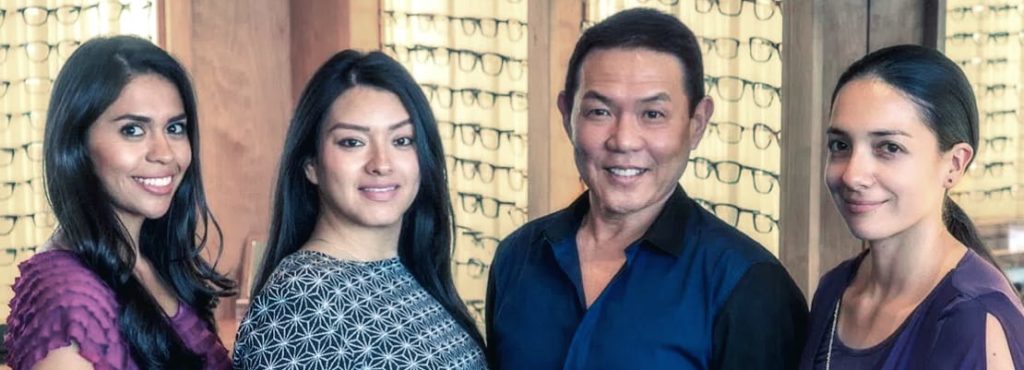Diagnosing & Treating Eye Diseases
Approximately 1 in 10 Americans lives with an eye disease that could permanently affect their vision. But our eye doctors can often help manage vision loss.
West Hollywood Optometric Center can monitor your eyes for disease during eye exams and take action to protect your vision while there’s still time. Don’t let an eye disease grow into something you can’t control. Let us take care of your eye health today!

Eye Diseases To
Be Aware Of
Age-Related Macular Degeneration
Age-related macular degeneration (AMD) typically affects people older than 50 and can cause significant vision loss. AMD occurs when a part of your retina called the macula deteriorates, impairing your central vision as a result.
Since central vision is essential for everyday activities like reading and driving, it’s important to catch and manage as AMD early as possible. Booking eye exams more frequently after age 50 gives us more chances to diagnose this condition and help control its outcome.
Glaucoma
Glaucoma is one of the most common causes of permanent blindness in the world. This family of diseases is characterized by optic nerve damage, which is generally caused by high pressure within the eye.
Depending on what kind of glaucoma you have, you might experience no symptoms for months or many symptoms very quickly—in which case you should consider it a medical emergency. Regular eye exams are vital for detecting glaucoma before it threatens your vision so you and your eye doctor can work to manage it effectively.
Cataracts
Cataracts develop when proteins clump together on the clear lens of your eye, causing your vision to become milky or blurry. Most cataracts occur in people over 40 years old, although other risk factors, such as diabetes, can cause them to develop earlier.
An ophthalmologist may be able to surgically remove the affected lens and put a synthetic one in its place to restore your vision. If you’re concerned about cataracts, contact us for an accurate diagnosis and learn about your options.
Conjunctivitis
When the membrane covering the white of your eye becomes inflamed, it might look red or pink. Some people might call that “pink eye,” but we call it conjunctivitis. Untreated conjunctivitis can eventually cause an inflammation of the cornea, which might threaten your vision.
There are different kinds of conjunctivitis, including:
- Viral conjunctivitis: normally caused by common cold viruses, this type of conjunctivitis can make you sensitive to light and cause your eyes to produce yellow or green discharge.
- Allergic conjunctivitis: typically caused by allergens like mold spores, dust, or pollen, this non-contagious form of conjunctivitis can present cold-like symptoms. Your eyes might also feel itchy or watery, or you could experience a burning sensation.
- Bacterial conjunctivitis: spread by bacteria, this is one of the most contagious forms of conjunctivitis. It often creates discharge in your eyes that can solidify while you sleep and make them stick together in the morning.
- Chemical conjunctivitis: a type of eye emergency caused by chemical exposure, this type of conjunctivitis is non-contagious but requires medical attention ASAP to reduce the possibility of vision loss. Contact us if your eyes have been exposed to toxic liquids, fumes, or smoke of any kind.
Diabetic Eye Disease
The number of Americans with diabetic eye diseases is steadily rising. Living with diabetes raises your risk for cataracts and glaucoma while making you potentially vulnerable to diabetic retinopathy and diabetic macular edema.
Routine eye exams allow your eye doctor to detect early warning signs of these diseases—and sometimes even diabetes itself. Once you know what you’re dealing with, you can work with your eye doctor and general practitioner to manage your risks properly.
The Best Defense for Your Eyes
Don’t let your vision become a victim of eye disease. Schedule your next exam at our practice by contacting us today.
See Us In West Hollywood
We can’t wait to help you make the best possible use of your eyes. Our practice is on Santa Monica Boulevard, near the intersection of Havenhurst Drive.

Our Address
- 8205 Santa Monica Boulevard, Suite 15
- West Hollywood, CA 90046
Contact Information
- Phone: 323.650.0337
- Email: [email protected]
Our Hours
- Monday: 10:00 AM – 5:00 PM
- Tuesday: 10:00 AM – 5:00 PM
- Wednesday: 10:00 AM – 5:00 PM
- Thursday: 9:00 AM – 5:00 PM
- Friday: 9:00 AM – 5:00 PM
- Saturday: 10:00 AM – 3:00 PM
- Sunday: Closed
Note: Saturday hours reflect the 2nd and 4th Saturday of each month.
Our Eye Care Services
Our Brands









